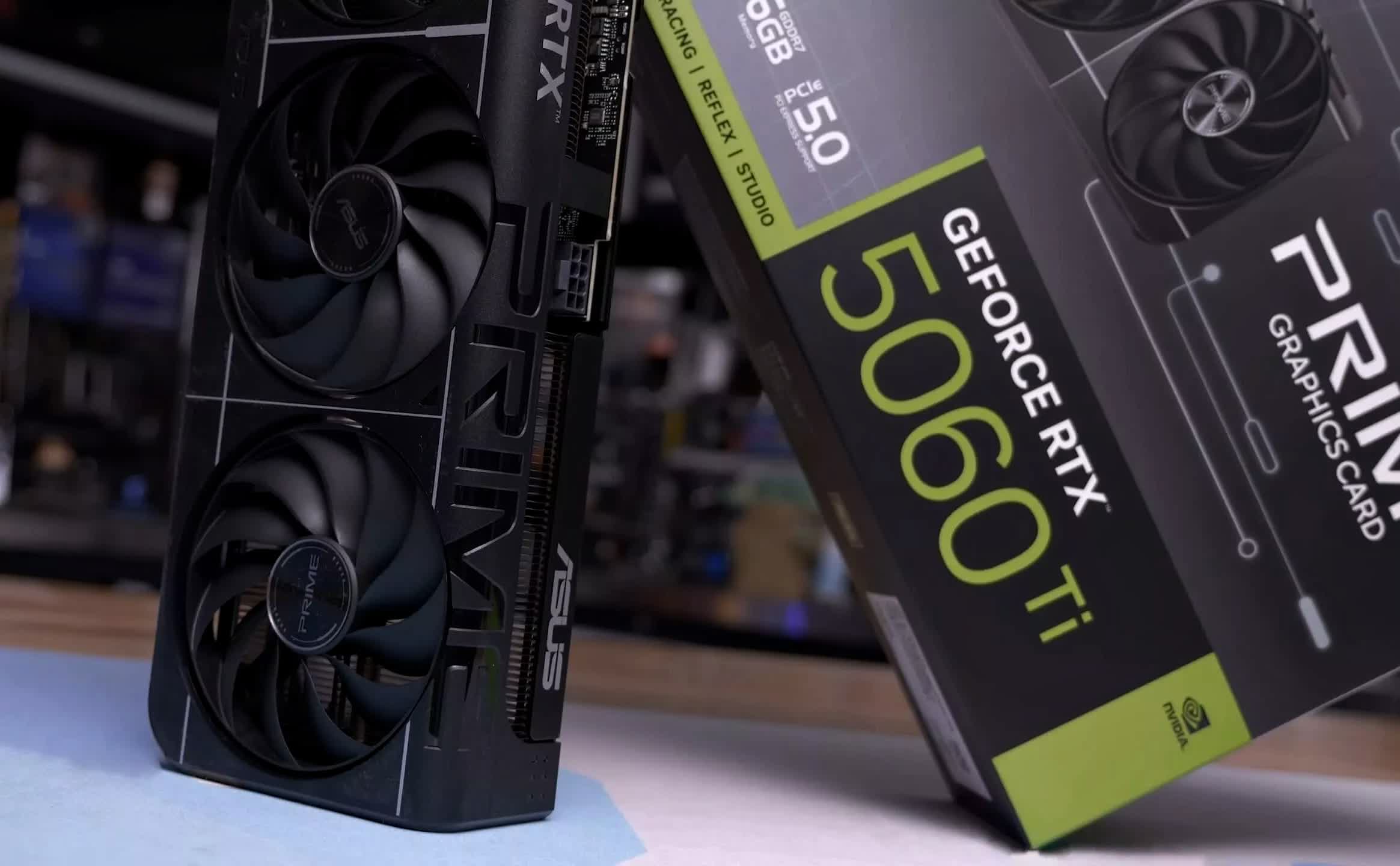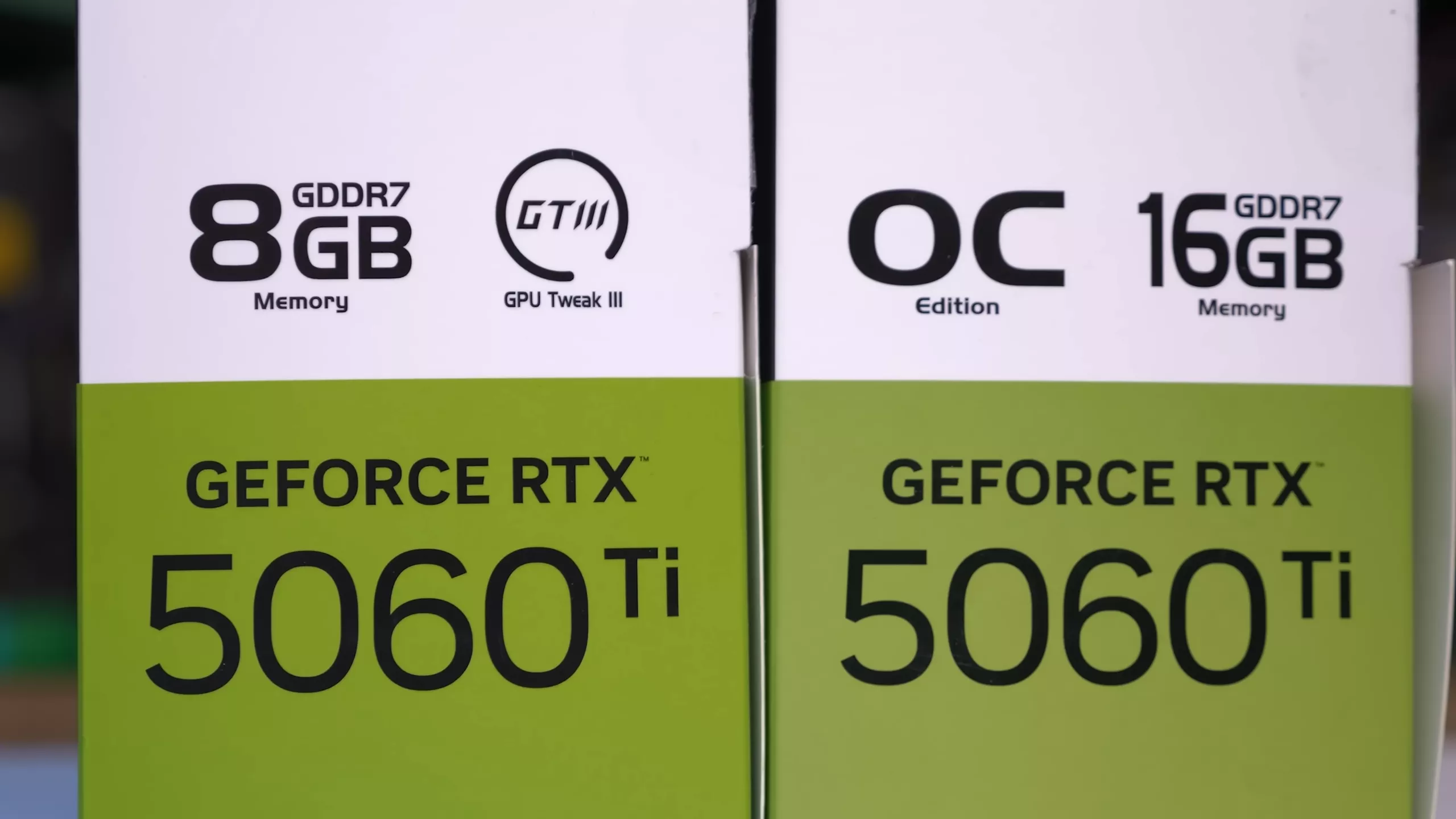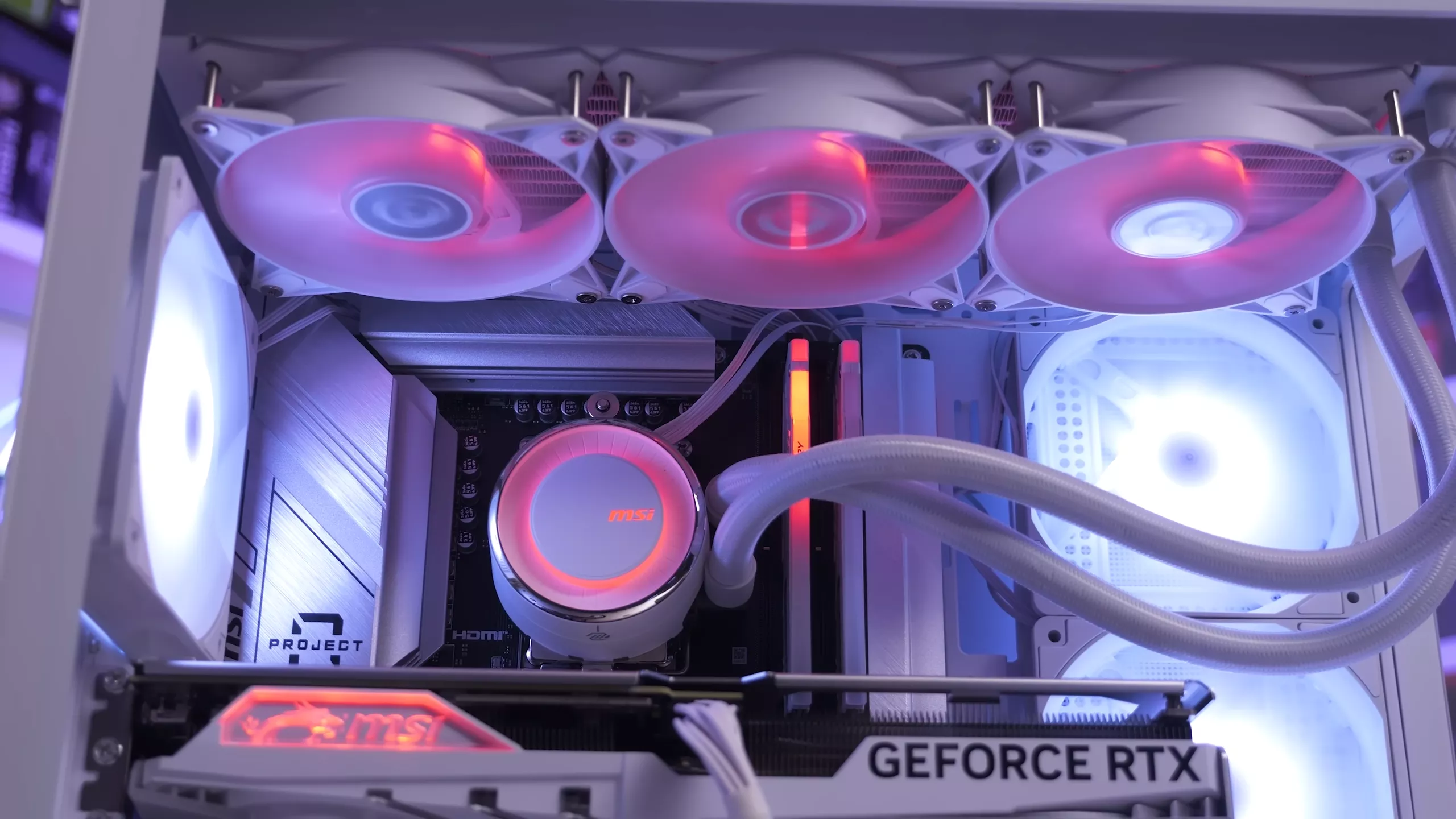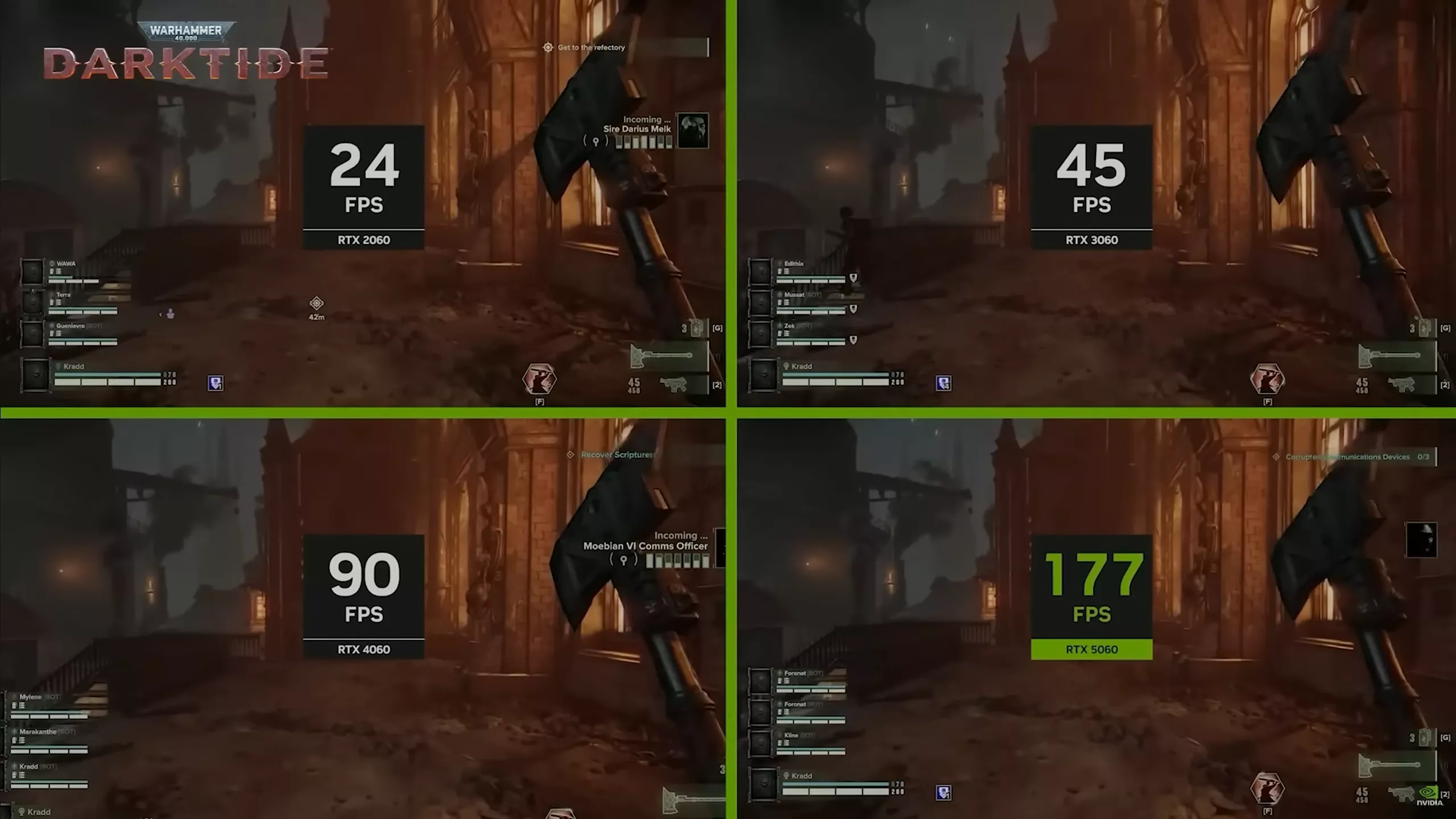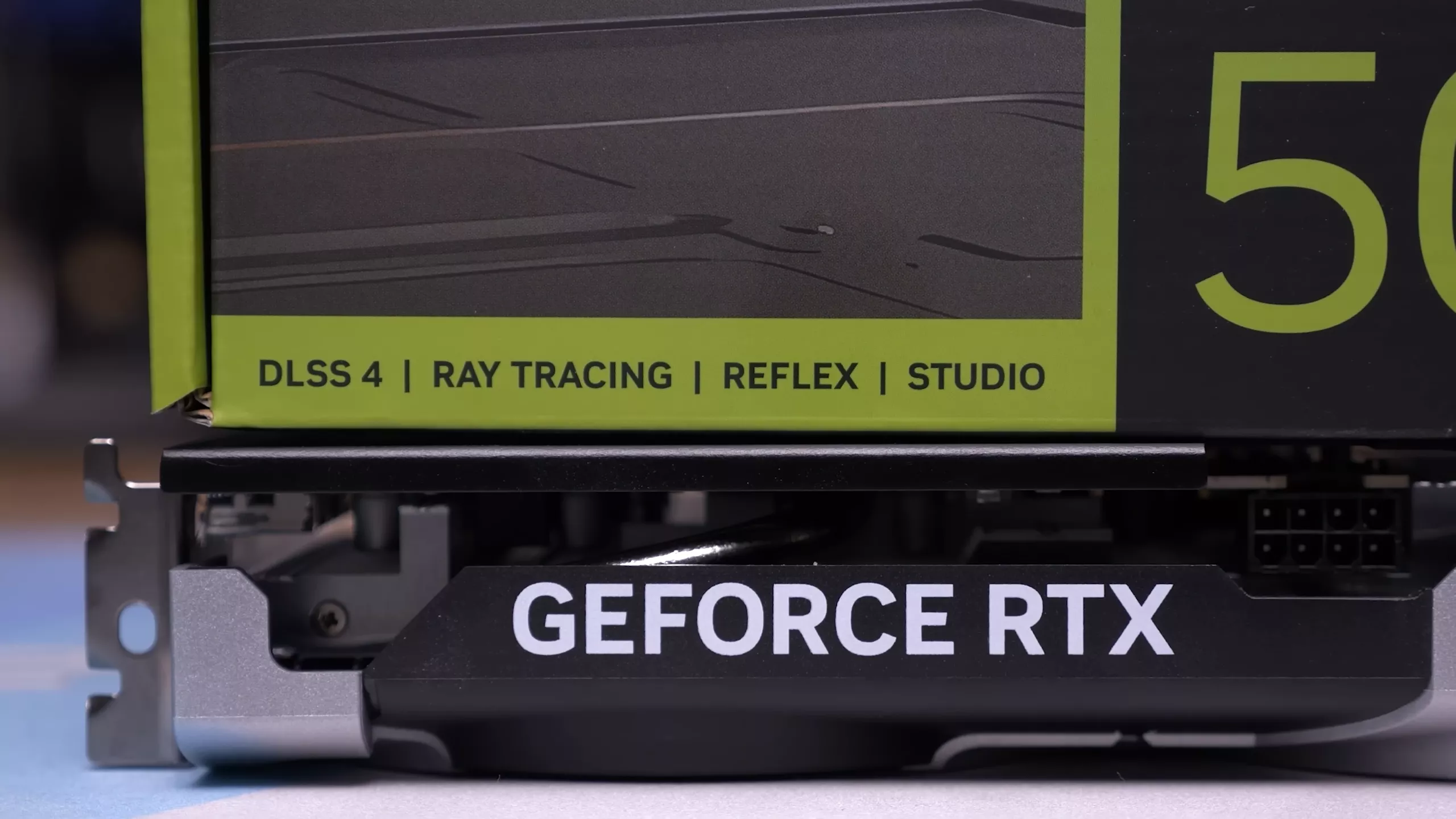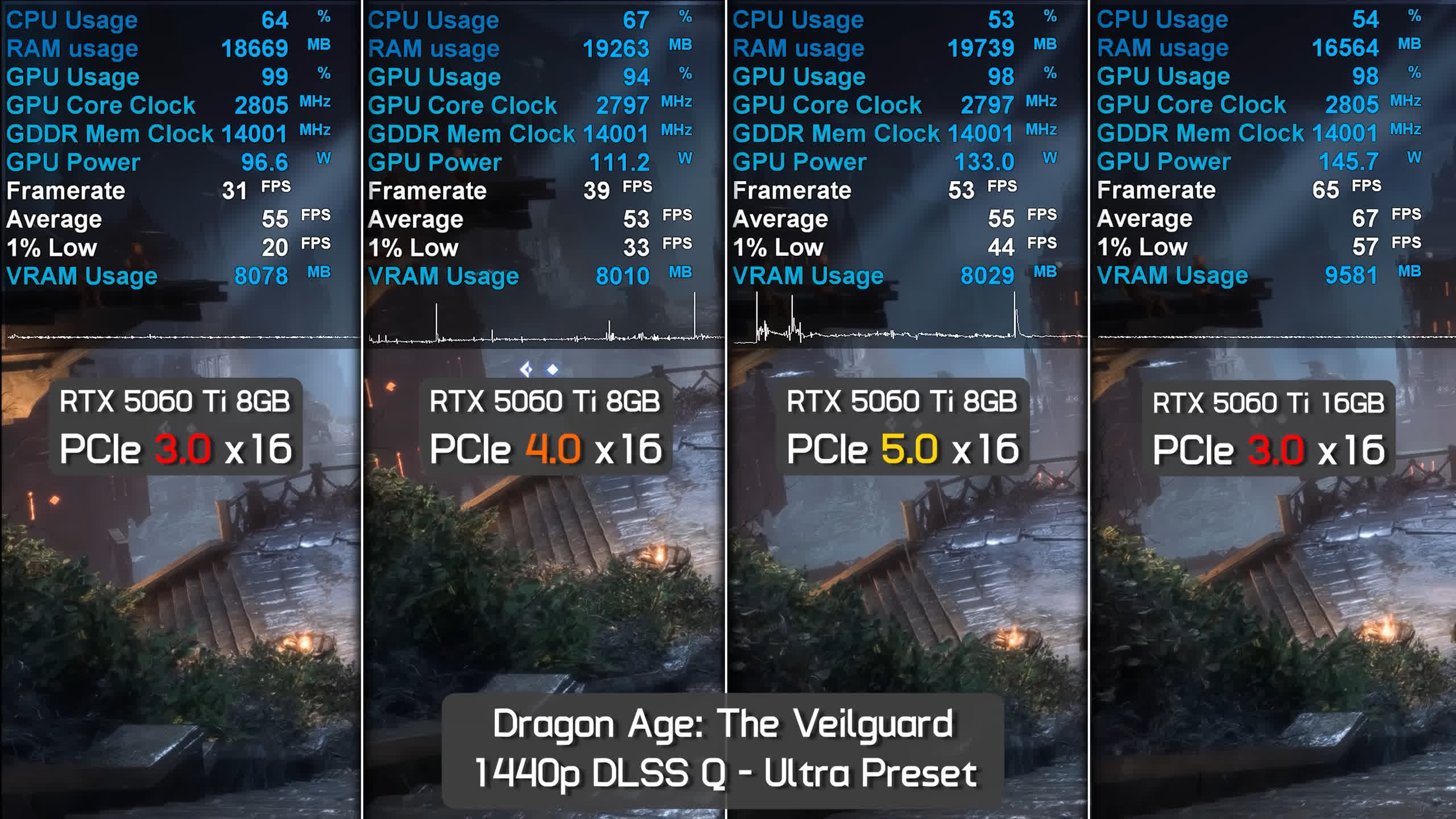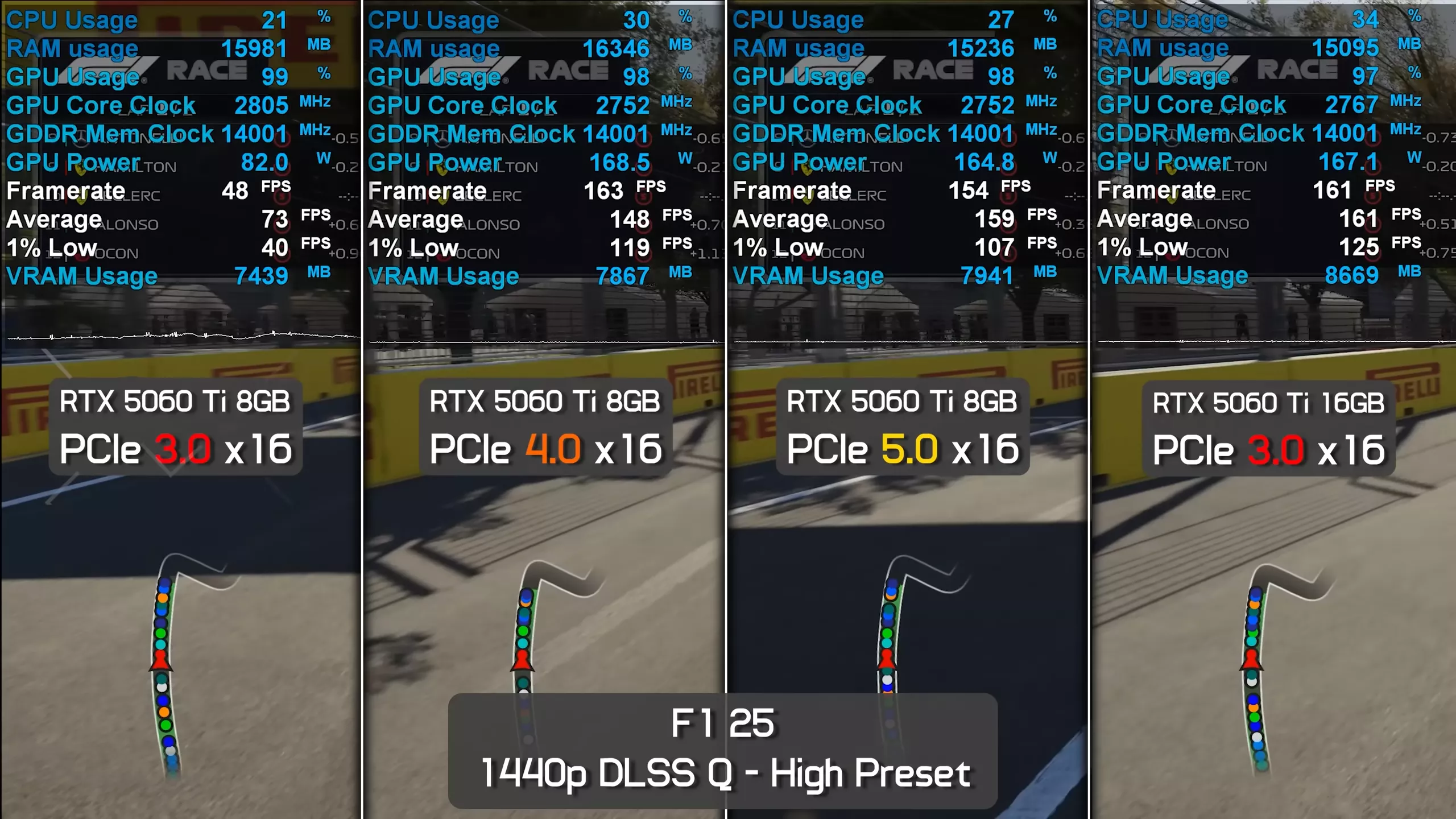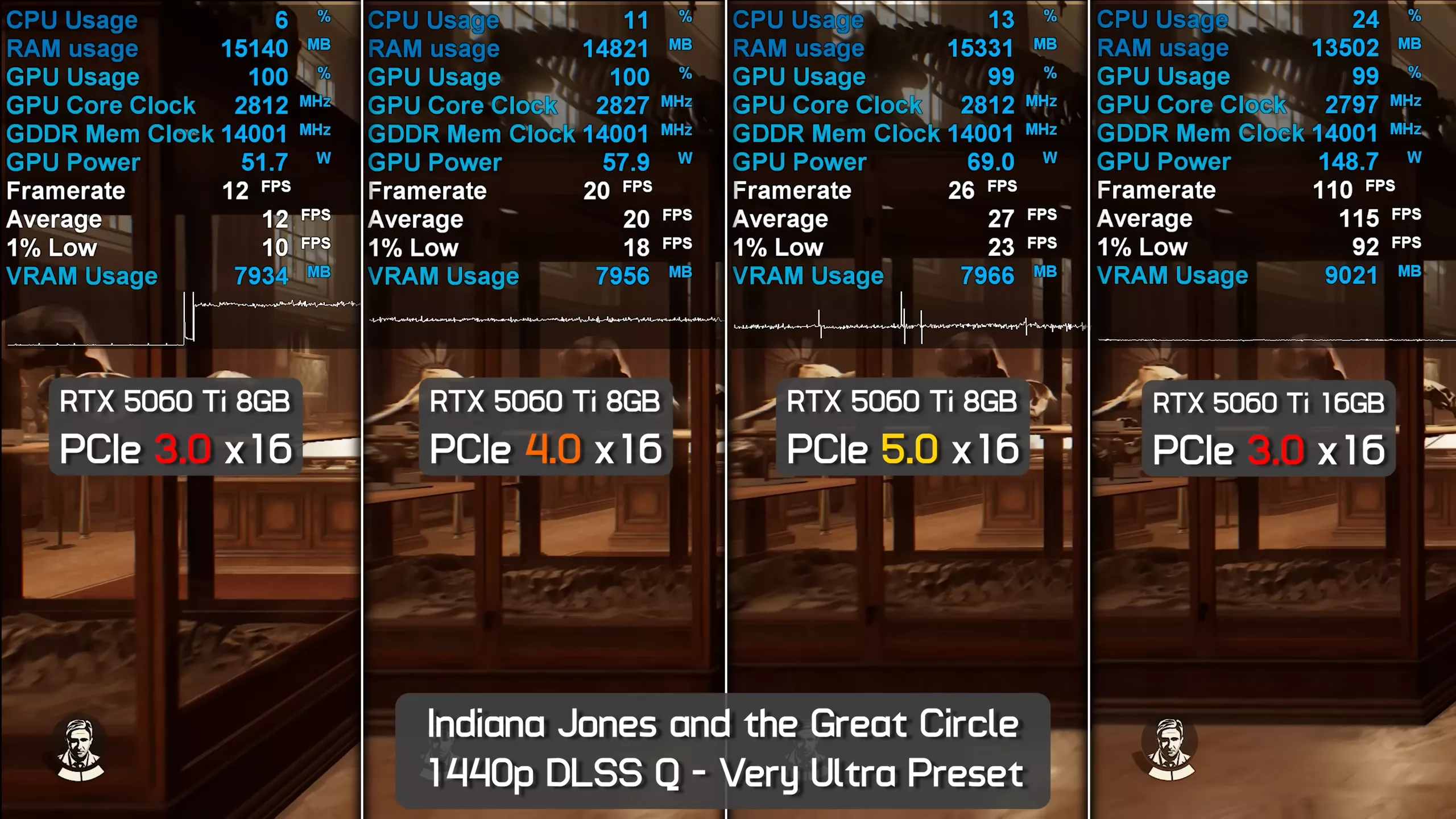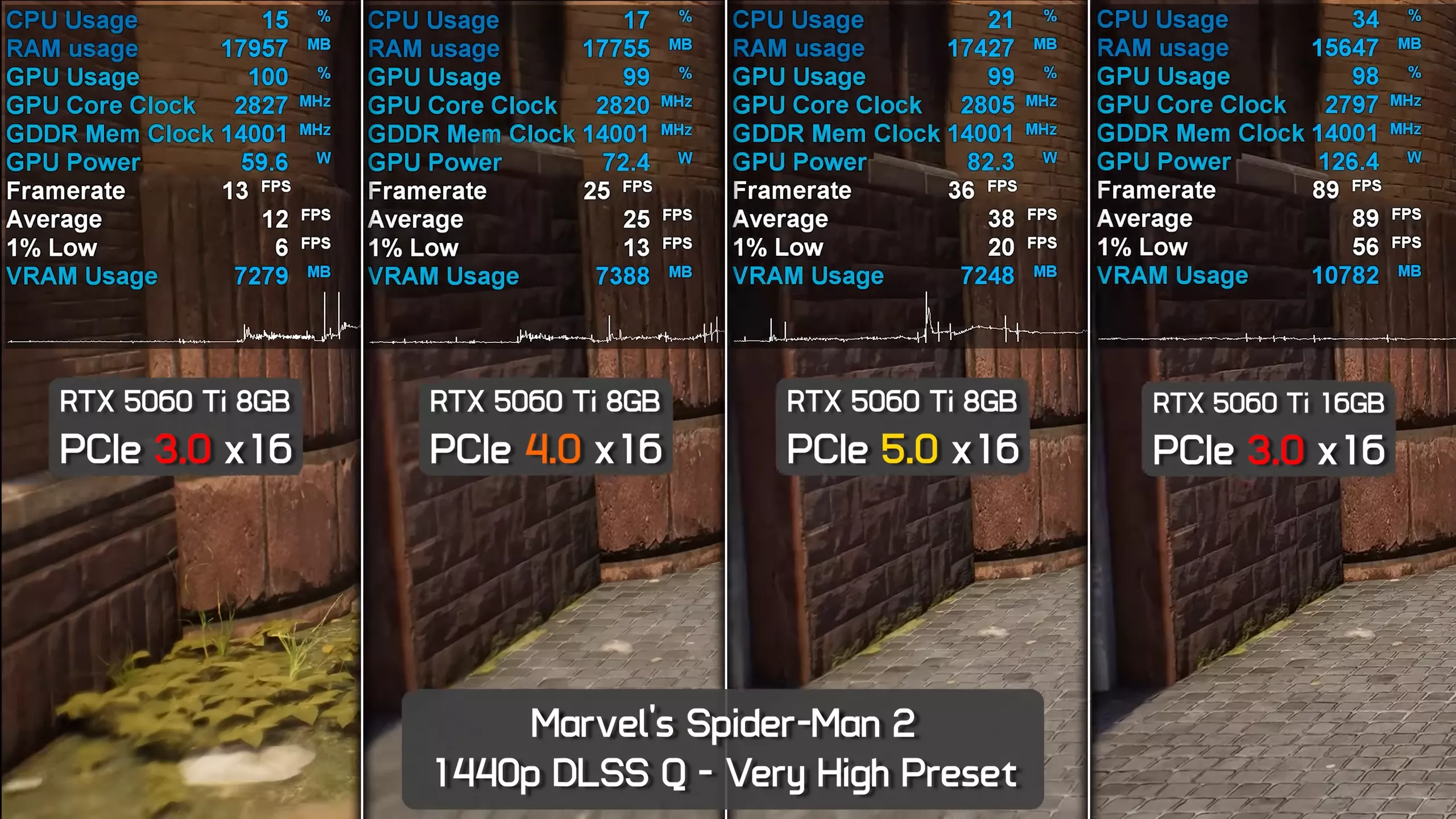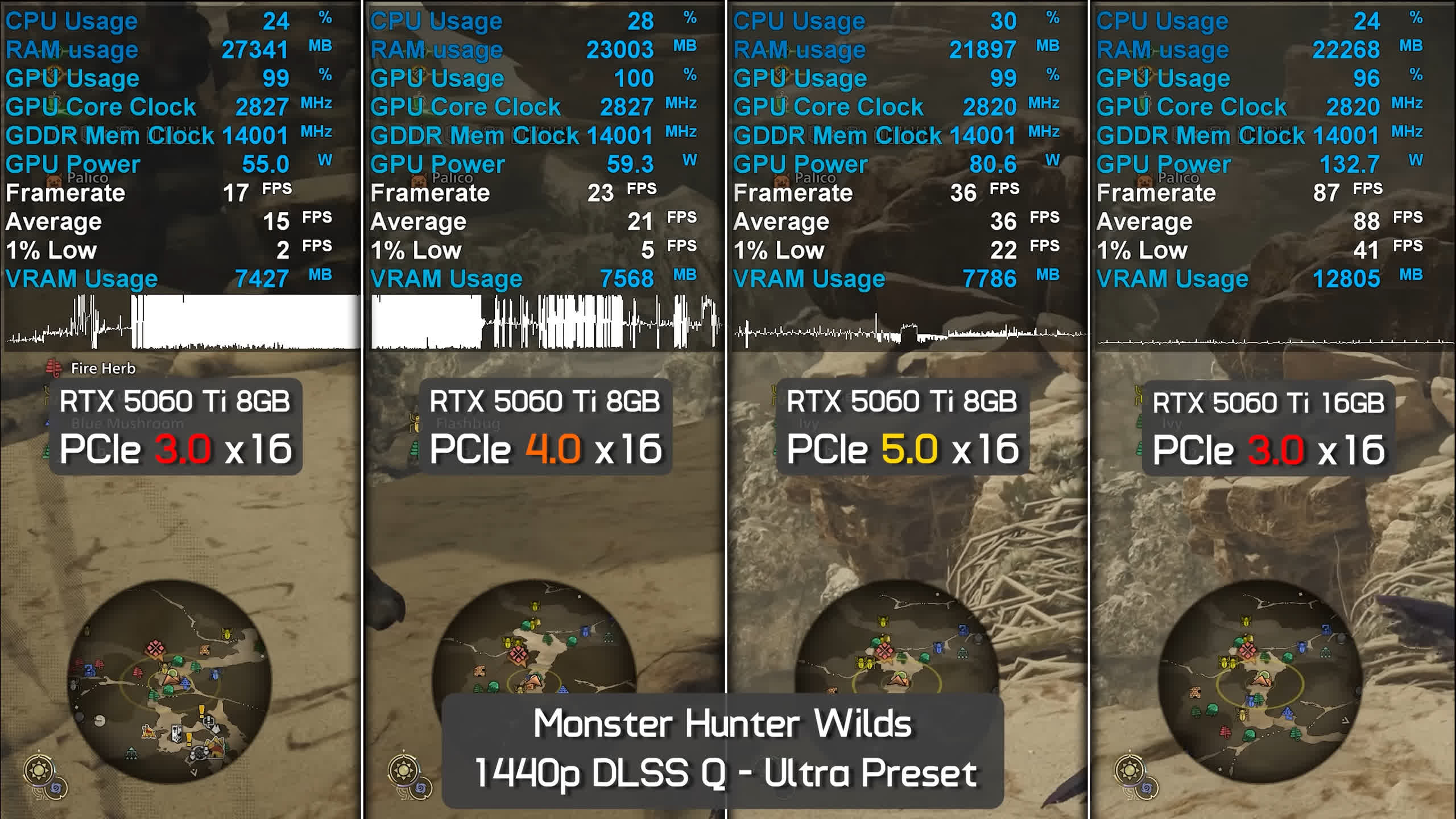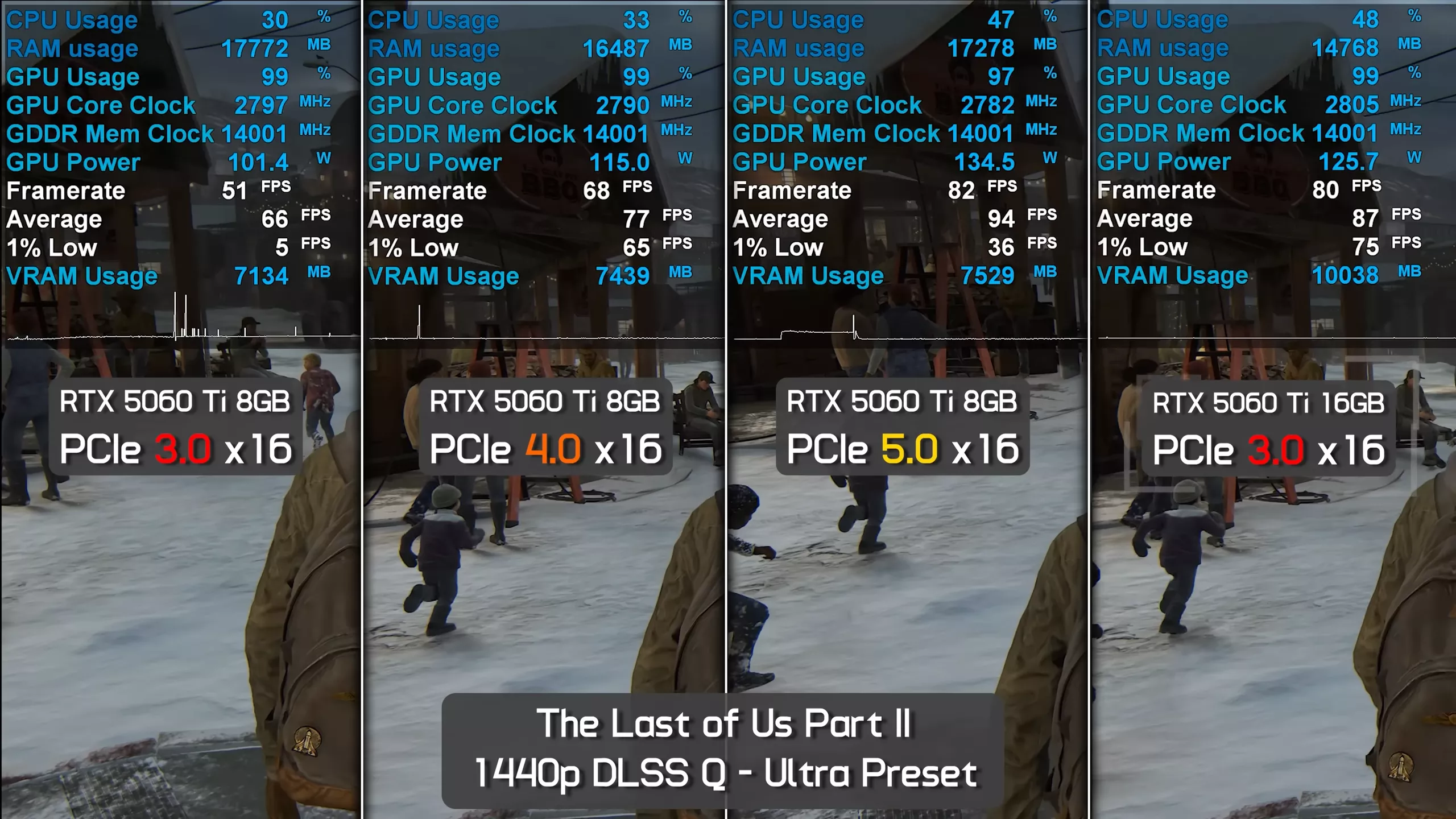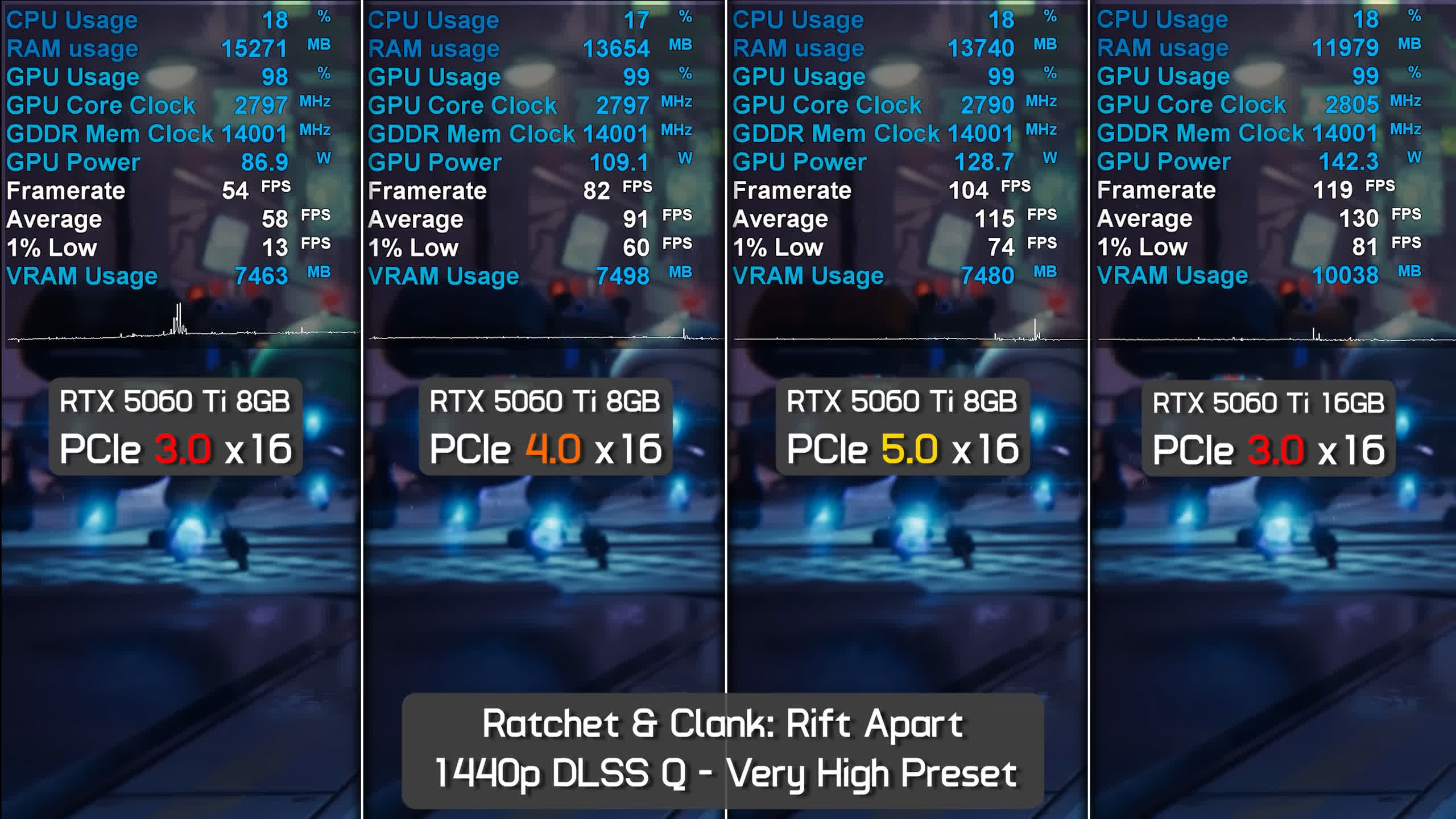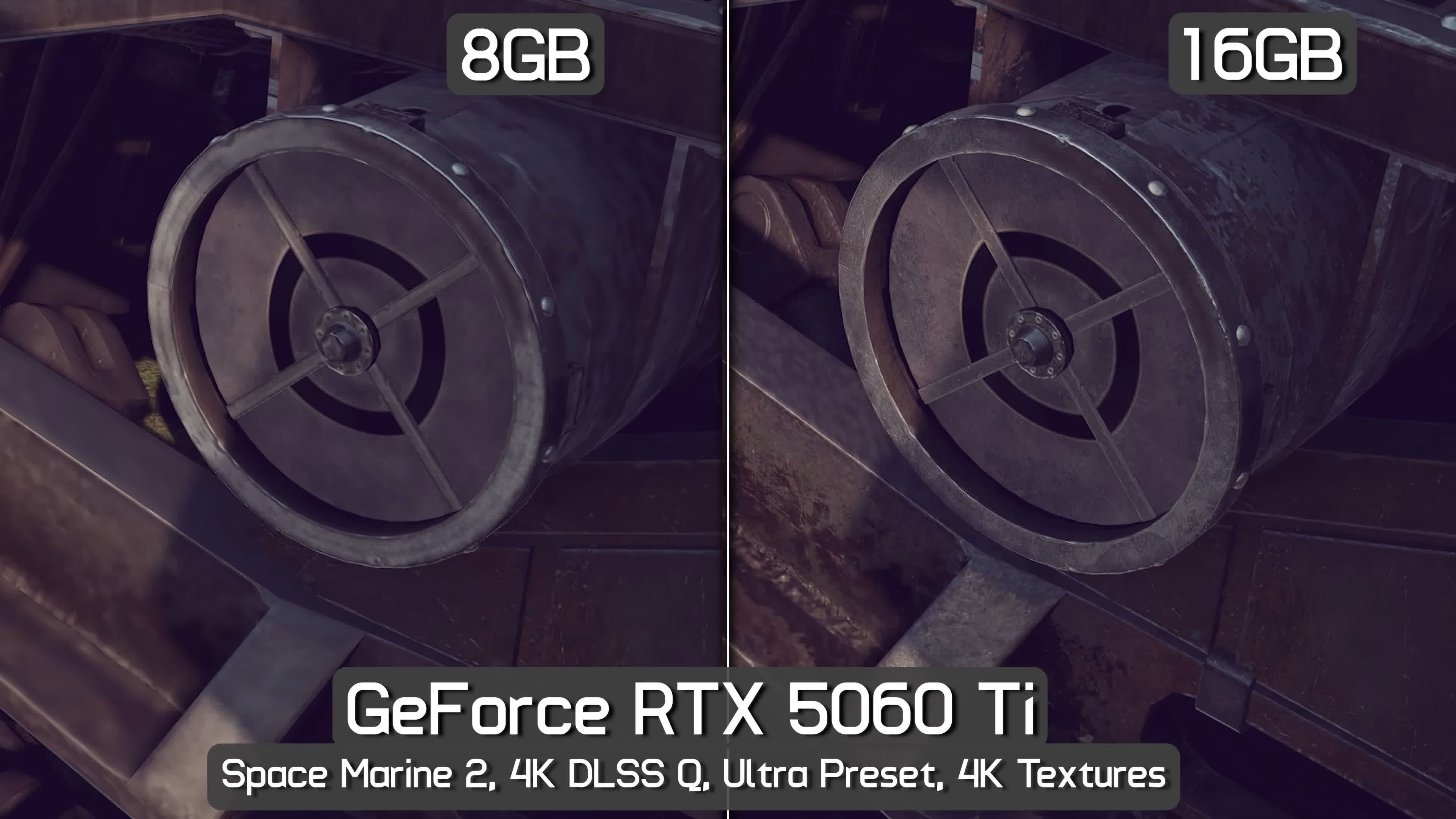Recently we examined how PCI Express bandwidth influences the performance of the 8 GB Radeon RX 9060 XT when local video memory (VRAM) is exceeded. The entire purpose of that testing was to push past the VRAM limit, which, unfortunately for 8 GB graphics cards, is a relatively easy task in 2025. This can happen even when using settings that would otherwise be highly playable, as demonstrated by the 16 GB model.
This is an interesting test for several reasons, the most notable being that PCIe bandwidth becomes a primary bottleneck when required VRAM is exceeded. Increasing bandwidth can help reduce the performance penalty of moving game assets into local system memory (RAM).
Understanding VRAM and PCIe Bandwidth
To briefly explain, when VRAM runs out, game assets are shifted to system RAM. The data must pass through the PCI Express bus to the CPU's memory controller and then out to RAM, where it can be stored.
The reason why this is often catastrophic for performance is bandwidth. In the case of the GeForce RTX 5060 Ti, the VRAM has a peak bandwidth of 448 GB/s, which is quite a lot. In contrast, the theoretical peak bandwidth for system memory is much lower – around 96 GB/s for dual-channel DDR5-6000 and approximately 50 GB/s for dual-channel DDR4-3600, depending on several factors.
| RTX 5060 | RTX 5060 Ti | RTX 5070 | RTX 5070 Ti | RTX 5080 | |
|---|---|---|---|---|---|
| Price MSRP | $300 | $380 / $430 | $550 | $750 | $1,000 |
| Release Date | May 2025 | April 2025 | Mar 2025 | Feb 2025 | Jan 2025 |
| Process | TSMC 4N | ||||
| Die Size (mm²) | 181 mm² | 263 mm² | 378 mm² | ||
| Core Config | 3840 : 120 : 48 | 4608 : 144 : 48 | 6144 : 192 : 80 | 8960 : 280 : 96 | 10752 : 336 : 112 |
| L2 Cache (MB) | 32 MB | 48 MB | 64 MB | ||
| GPU Boost Clock | 2497 MHz | 2572 MHz | 2512 MHz | 2452 MHz | 2617 MHz |
| Memory Capacity | 8 GB | 8 GB / 16 GB | 16 GB | ||
| Memory Speed | 28 Gbps | 30 Gbps | |||
| Memory Type | GDDR7 | ||||
| Bus Type / Bandwidth | 128-bit, 448 GB/s | 192-bit, 672 GB/s | 256-bit, 896 GB/s | 256-bit, 960 GB/s | |
| PCIe Bus Interface | PCIe 5.0 x8 | PCIe 5.0 x16 | |||
| Total Board Power | 145 W | 180 W | 250 W | 300 W | 360 W |
The key takeaway is that 50 to 96 GB/s is considerably less than 448 GB/s, and this doesn't even account for increased latency. These figures also ignore the PCIe interface as a potential bottleneck, which can further reduce effective bandwidth depending on the setup.
PCI Express 5.0, for example, provides a bi-directional bandwidth of 128 GB/s with all 16 lanes available. That drops to 64 GB/s for PCIe 4.0 and 32 GB/s for PCIe 3.0. However, the RTX 5060 Ti is limited to just 8 lanes, so these figures are halved again: 64 GB/s for PCIe 5.0, 32 GB/s for PCIe 4.0, and only 16 GB/s for PCIe 3.0.
This means that when the 8 GB VRAM limit is exceeded, performance could be significantly better on PCIe 5.0 compared to 4.0 or 3.0. And that's exactly what we explore in this review.
For testing the RTX 5060 GPUs, we will focus on upscaled 1440p – so not native 1440p, but also not 1080p. As we've demonstrated in the past, it's very easy to overwhelm 8 GB GPUs at 1080p in modern games using settings that are still very playable on a 16 GB model. Furthermore, these 8 GB GPUs were not 'intended' or 'designed' specifically for 1080p gaming. That claim is simply untrue and not reflected in how these products have been marketed.
AMD, for example, has consistently promoted the 9060 XT as offering ultra-fast 1440p gaming. Nvidia has also officially showcased the 5060 Ti at 1440p using maximum quality settings, albeit with 4x frame generation enabled. The point is, neither company is marketing these $300+ GPUs as 1080p-only solutions, and rightly so. At this price point, buyers should expect capable 1440p performance, which happens to be what you receive as long as you purchase the 16GB model.
Our test bed will be our usual high-end 9800X3D test system to assess PCIe performance specifically. This allows us to isolate the PCIe bus and evaluate how much PCIe bandwidth influences performance when the GPU accesses system memory.
We measured the 8 GB 5060 Ti's performance using PCIe 3.0, 4.0, and 5.0, and compared it to the 16 GB 5060 Ti running on PCIe 3.0. This data is useful for users who don't have PCIe 5.0 systems, as many CPUs and platforms still rely on PCIe 4.0 or even 3.0.
Let's dive into the benchmarks.
Benchmarks
Dragon Age: The Veilguard
Starting with Dragon Age: The Veilguard, performance goes from bad to worse for the 8 GB model. But first, let's discuss the 16 GB card, which we tested using PCIe 3.0. When VRAM capacity is not exceeded, the PCIe mode has little impact on performance. In this case, the 16 GB card averaged 66 fps with a 1% low of 47 fps, delivering a very playable experience.
Under the same conditions using PCIe 3.0, the 8 GB model averaged just 27 fps with a 1% low of 9 fps. That made the 16 GB card 130% faster in terms of average frame rate and 411% faster for the 1% lows. Increasing the PCIe bandwidth to 4.0 improved the 8 GB card's average frame rate by 22% and its 1% lows by 111%. Moving up to PCIe 5.0 brought a further 12% gain in average frame rate, with a similar improvement in 1% lows.
Even with PCIe 5.0, the 8 GB model was unable to deliver playable performance. The 16 GB card using PCIe 3.0 was still 68% faster on average and 119% faster for the 1% lows. While increased PCIe bandwidth helped somewhat, the 8 GB 5060 Ti performed so poorly in this test that the PCIe specification made little difference. Playable performance would still require lowering quality settings.
F1 25
Next is F1 25 using the high preset. It is important to note that 8 GB GPUs perform very poorly with the 'very high' preset, while 16 GB models still provide smooth performance.
Even at the high preset, the 8 GB model showed noticeable decline, with 1% lows roughly 30% lower than the 16 GB model, even when using PCIe 4.0 or 5.0. When limited to PCIe 3.0, the 16 GB card ended up 114% faster in average frame rate and 235% faster in 1% lows.
Indiana Jones and the Great Circle
In Indiana Jones, the 16 GB 5060 Ti averaged 118 fps with a 1% low of 96 fps. This provided a highly playable and smooth high-refresh-rate experience using PCIe 3.0, since the VRAM capacity was not exceeded.
The same cannot be said for the 8 GB model. It is difficult to understand how these two versions of the 5060 Ti share the same name, given the vast performance difference. Sure, reducing visual quality can match the performance, but the visual downgrade in this game is significant and very noticeable.
Frankly, it is astonishing that this situation is acceptable to some. The 16 GB model is not only delivering a smooth experience, but it is also up to 883% faster using the same PCIe 3.0 configuration.
Unfortunately, switching the 8 GB card to PCIe 4.0 or 5.0 makes little difference. With these settings – which run perfectly well on the 16 GB model – the 8 GB card is completely overwhelmed. It would be unwise not to see this as a clear indication of where things are heading.
Marvel's Spider-Man 2
We tested Marvel's Spider-Man 2 using the very high preset with quality upscaling at 1440p. This is not native 1440p – render resolution is actually closer to 1080p. Under these conditions, the 16 GB 5060 Ti achieved an impressive 90 fps with 1% lows of 56 fps, delivering highly playable performance.
Using PCIe 3.0, the 16 GB model was 592% faster than the 8 GB model. Even when the 8 GB card was moved to PCIe 4.0, the 16 GB version remained 210% faster, and still 120% faster when using PCIe 5.0. Due to its 8-lane PCIe limitation, the 8 GB model becomes practically unusable once VRAM capacity is exceeded, which is exactly the scenario tested here.
Monster Hunter Wilds
Monster Hunter Wilds is another example where PCI Express specification makes little difference when VRAM is the limiting factor. If you want to use the ultra quality preset and see all textures rendered properly, more than 8 GB of VRAM is absolutely required – even when gaming at 1080p.
While the 16 GB model averaged 84 fps under these conditions, the 8 GB version managed just 34 fps, with extremely poor 1% lows of 16 fps.
The Last of Us Part II
The Last of Us Part II is technically playable on an 8 GB graphics card, though you will encounter frequent frame time inconsistencies. In this test, the 16 GB model averaged 91 fps, making it 40% faster than the 8 GB version under identical settings. Switching the 8 GB model to PCIe 4.0 boosted its performance by 18%, reducing the performance gap to 18%. Finally, using PCIe 5.0, the 8 GB card reached 92 fps – matching the 16 GB card's average.
Ratchet & Clank: Rift Apart
Lastly, Ratchet & Clank: Rift Apart runs exceptionally well on the 16 GB model, averaging 133 fps. That makes it 110% faster than the 8 GB card using PCIe 3.0. The 8 GB card struggled significantly on PCIe 3.0, with very poor frame time performance. Moving to PCIe 4.0 resolved most of the issues, and the card reached 95 fps. However, the 16 GB model was still 37% faster. On PCIe 5.0, the 8 GB 5060 Ti performed well, offering similar 1% lows to the 16 GB model, although the 16 GB version remained 11% faster in average frame rate.
What We Learned
As we had come to expect, based on previous tests, exceeding VRAM capacity results in significantly worse performance when using PCI Express 4.0 or 3.0 compared to PCIe 5.0. While most scenarios led to completely unplayable performance, even the best cases showed a substantial performance hit.
For the most part, the 8 GB 5060 Ti is nearly unusable when VRAM is exceeded, largely due to its 8-lane configuration. Even PCIe 5.0 cannot overcome this limitation. The 9060 XT does perform better on PCIe 4.0 and 5.0, thanks to its full 16-lane interface, which provides twice the bandwidth under the same PCIe version.
The lesson is very clear: if you intend to do anything beyond playing esports titles at 1080p, you'll want to avoid the 8GB model like the plague. Even for esports players, we would recommend steering clear, if only for better resale value down the road.
Regardless of the settings used, if you're interested in playing modern AAA titles, wish to explore higher resolutions in the future, or plan to keep your graphics card for at least the next 2 years, under no circumstances will you want to purchase the 8GB versions of either the 9060 XT or 5060 Ti. Choosing one of these models will likely force you to upgrade sooner than expected, and in the meantime, you'll often be stuck tweaking settings to avoid frame time spikes and subpar performance.
What we find most confusing about the 8 GB vs 16 GB debate – no matter which side of the fence you're on – is how anyone can defend a product using the exact same name for two very different configurations, a choice that can result in radically different performance.
Even if you are of the opinion that 8GB is still fine and it's all you need ... how do you justify two products with the exact same name, delivering radically different performance, using settings that proved highly playable for the 16GB model?
Take F1 25 as an example. Using the high preset (not even the maximum setting), the 8 GB model delivered playable performance, which is a positive. However, the 16 GB version was 114% faster on PCIe 3.0, and up to 30% faster when the 8 GB card used PCIe 4.0 or 5.0. How is it acceptable for the same product to perform 30% better simply because it has more VRAM?
We cannot recall a time when it was considered acceptable for two configurations of the same product to differ by 30% in realistic conditions. A similar pattern was observed in Ratchet & Clank. On PCIe 4.0, the 8 GB model averaged 96 fps, which is respectable. But even then, the 16 GB card on PCIe 3.0 was nearly 40% faster. That is a massive gap for two cards marketed under the same model... and these are some of the better outcomes for the 8 GB model.
We also do not understand the argument that the 8 GB version is intended for "low" or "medium" settings in games like Indiana Jones and the Great Circle. That logic simply does not hold up. If it had a different product name and was marketed as a lower-tier offering for modest settings, perhaps that would make sense. But that is not the case. In fact, the opposite is true – both AMD and Nvidia promoted these products based on the performance capabilities of the 16 GB versions.
